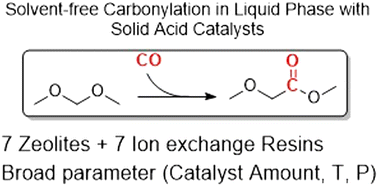Carbonylation of dimethoxymethane: a study on the reactivity of different solid acid catalysts†
Abstract
The carbonylation of dimethoxymethane (DMM) to methyl methoxyacetate (MMA) has gained interest in recent years not only due to its application as an important fine chemical, but also as a possible intermediate to produce ethylene glycol (EG) as well as a possible fuel additive. Employing different zeolites and ion exchange resins as catalysts, this paper systematically studied the effects of catalyst amount, temperature, carbon monoxide (CO) pressure and reaction conditions on educt conversion and product selectivities, using a parallel high pressure reactor plant. The reaction was performed in the liquid phase without using an additional solvent. The highest DMM conversion was achieved by catalyst Z-30 (ZSM-5; MFI type zeolite) and Amberlyst 36 (sulfonated ion exchange resin). The lowest DMM conversion was shown by H-Y-30 (Y; FAU-type zeolite) and Amberlyst 46. According to the analytical measurements via off-line gas chromatography (GC), the product spectrum includes, besides MMA, higher oxymethylene ethers (OME) like OME2, OME3, the carbonylation products of higher OMEs, methyl formate (MeFo) and formaldehyde (FA). The herein reported catalysts and parameter screenings for the carbonylation of DMM to MMA will assist the optimisation of this reaction as a promising industrial manufacturing process.



 Please wait while we load your content...
Please wait while we load your content...